Satas D., Tracton A.A. (ed.). Coatings Technology Handbook
Подождите немного. Документ загружается.

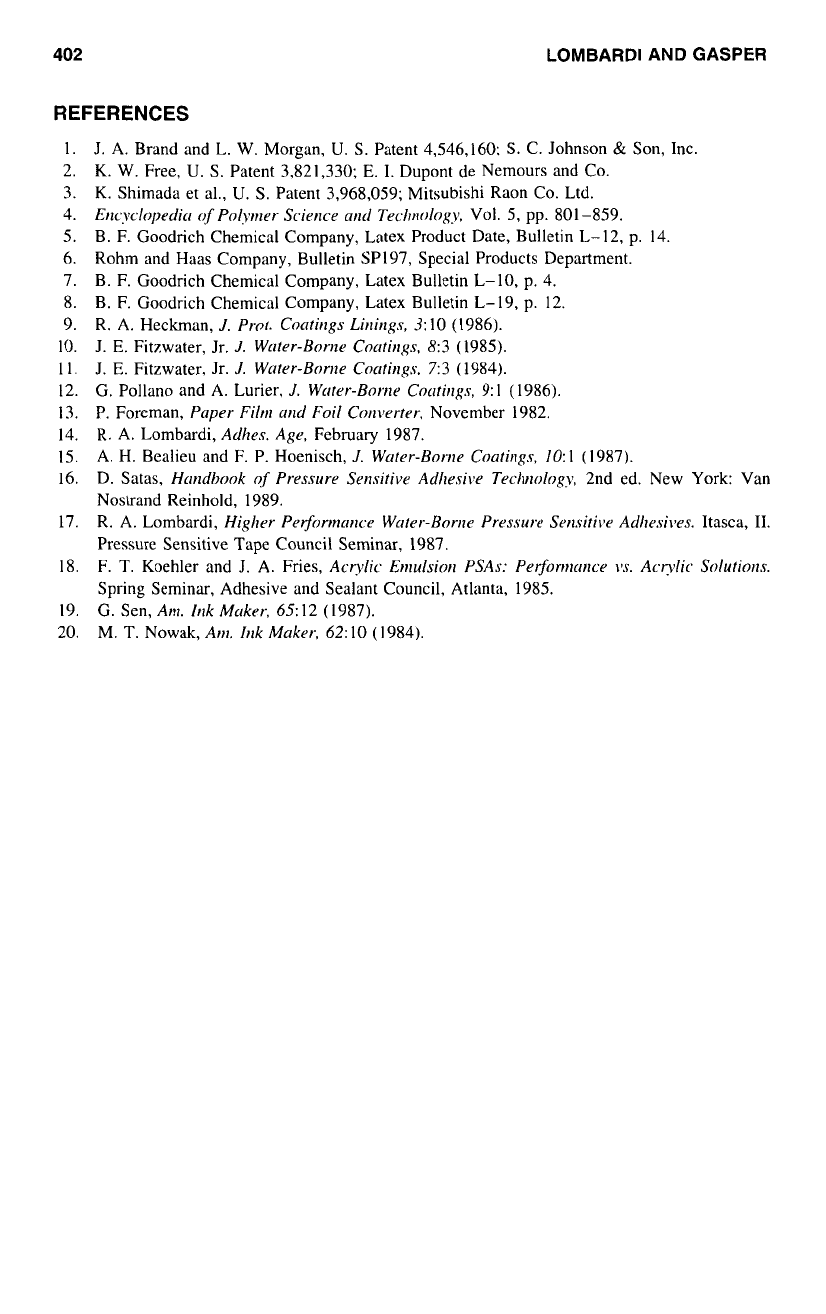
402 LOMBARD1 AND GASPER
REFERENCES
1.
2.
3.
4.
5.
6.
7.
8.
9.
IO.
11.
12.
13.
14.
15.
16.
17.
18.
19.
20.
J.
A.
Brand and L.
W.
Morgan,
U.
S.
Patent 4,546,160;
S.
C. Johnson
&
Son, Inc.
K.
W.
Free,
U.
S.
Patent 3,821,330;
E.
I.
Dupont de Nemours and Co.
K.
Shimada et al.,
U.
S.
Patent 3,968,059; Mitsubishi Raon Co. Ltd.
Encvclopedicr
of
Polymer Science
and
Techr~ology,
Vol. 5, pp. 801-859.
B. F. Goodrich Chemical Company, Latex Product Date, Bulletin
L-12,
p. 14.
Rohm and Haas Company, Bulletin SP197, Special Products Department.
B. F. Goodrich Chemical Company, Latex Bulletin L-IO, p. 4.
B. F. Goodrich Chemical Company, Latex Bulletin
L-19,
p.
12.
R.
A.
Hechan,
J.
Prot. Contirlgs Lblirlgs,
3:
IO
(1986).
J.
E.
Fitzwater, Jr.
J.
Water-Borne Cocrtiqs.
8:3
(1985).
J.
E.
Fitzwater, Jr.
J.
Water-Borne Coatirlgs.
7:3
(1984).
G. Pollano and
A.
Lurier,
J.
Wcrter-Borne Co(~ti~lg.s,
9:l
(1986).
P. Foreman,
Paper Film
and
Foil
Corzverter,
November 1982.
R.
A. Lombardi,
Adhes.
Age,
February 1987.
A. H. Bealieu and
F.
P. Hoenisch,
J.
Water-Borne
Coatings,
IO:
1
(1987).
D. Satas,
Hmdbook
of
Pressure Sensitive Adhesiw Technology,
2nd ed. New York: Van
Nostrand Reinhold, 1989.
R. A. Lombardi,
Higher Perjormmce Water-Borne Pressure Sensitive Adhesiws.
Itasca,
11.
Pressure Sensitive Tape Council Seminar, 1987.
F.
T. Koehler and J.
A.
Fries,
Acrylic EIIIUIS~~II PSAs: Perjorn~crrlce
1's.
Acgdic Solutions.
Spring Seminar, Adhesive and Sealant Council, Atlanta, 1985.
G. Sen,
Am.
Ink
Muker,
65:12 (1987).
M.
T. Nowak,
Am.
Iuk
Maker,
62:
IO
(1
984).
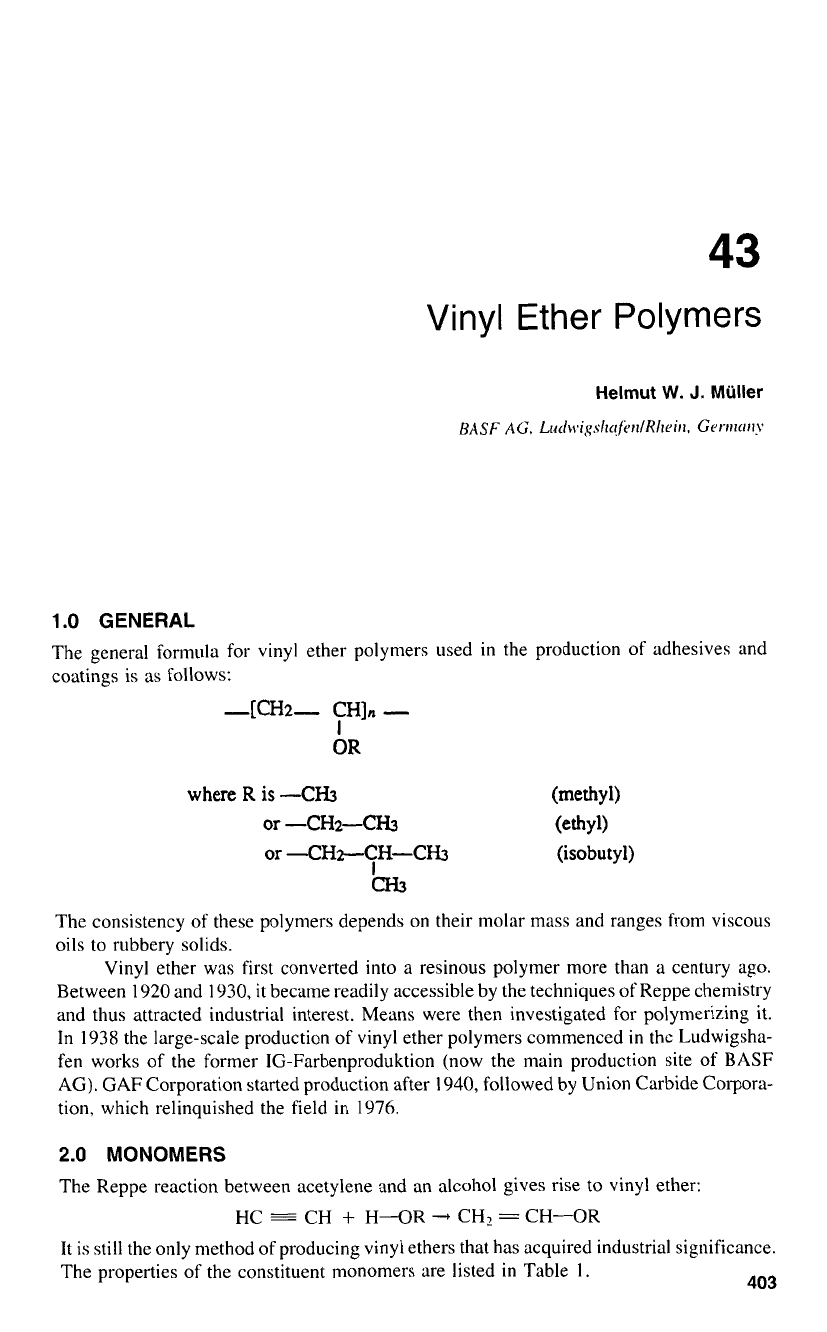
43
Vinyl Ether Polymers
1
.O
GENERAL
The general formula for vinyl ether polymers used in the production of adhesives and
coatings is as follows:
-[CH2-
CH]n
-
I
OR
where
R
is
“CH3
(methy
1)
or
“cH2-CH3
(ethyl)
or
“CH2-CH-CH3
(isobutyl)
CH3
I
The consistency
of
these polymers depends on their molar mass and ranges from viscous
oils
to rubbery solids.
Vinyl ether was first converted into a resinous polymer more than a century ago.
Between
1920
and
1930,
it
became readily accessible by the techniques
of
Reppe chemistry
and thus attracted industrial interest. Means were then investigated for polymerizing it.
In
1938
the large-scale production of vinyl ether polymers commenced
in
the Ludwigsha-
fen works of the former IC-Farbenproduktion (now the main production site of BASF
AG). GAF Corporation started production after
1940,
followed by Union Carbide Corpora-
tion, which relinquished the field in
1976.
2.0
MONOMERS
The Reppe reaction between acetylene and an alcohol gives rise to vinyl ether:
HC
E
CH
+
H”OR
-t
CH-,
=
CH-OR
It is still the only method
of
producing
vinyl
ethers that has acquired industrial significance.
The properties of the constituent monomers are listed
in
Table
1.
403
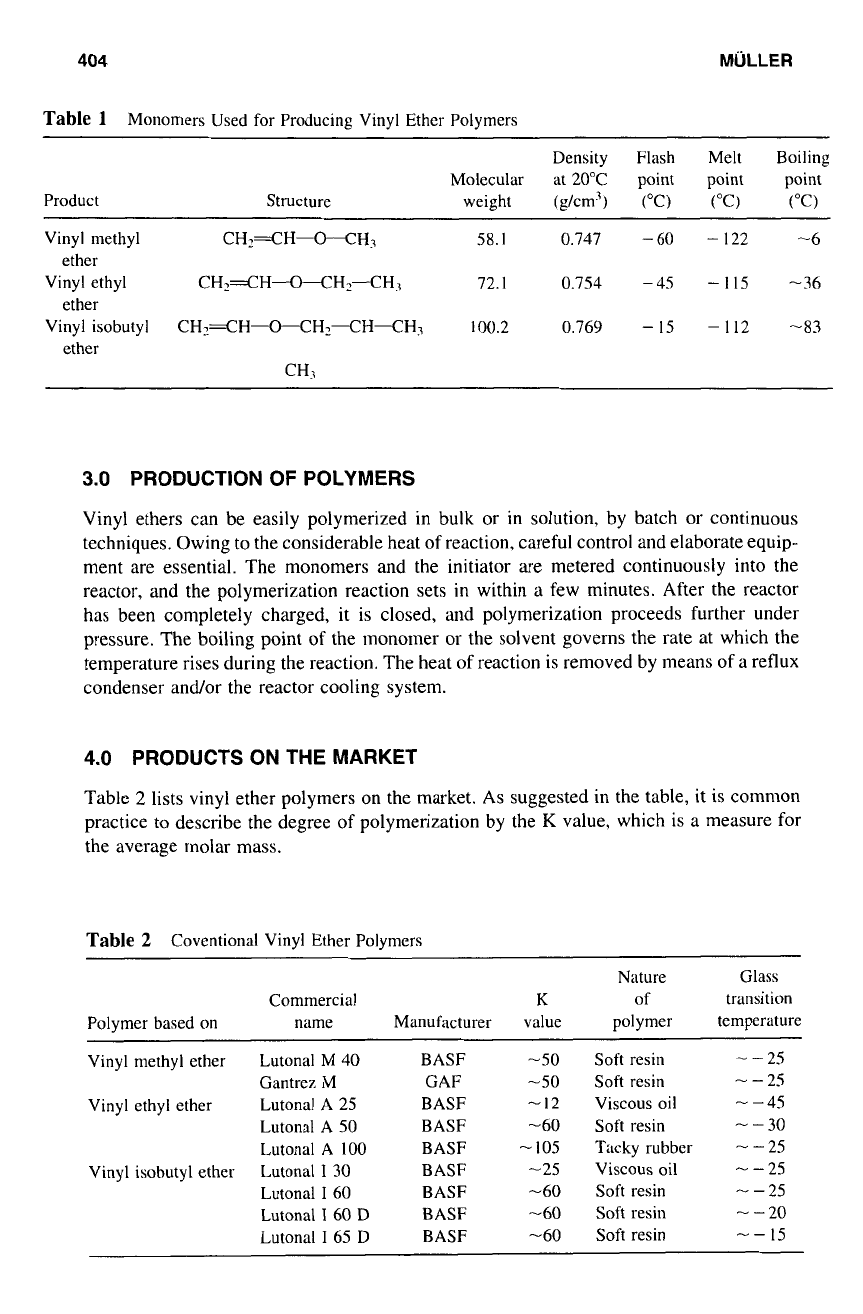
404
MULLER
Table
1
Monomers Used for Producing Vinyl Ether Polymers
Product
Density Flash Melt Boiling
Molecular at 20°C point point point
Structure weight (g/cm3) ("C) ("C)
("C)
Vinyl methyl
CHZ=CH--O"CH3
58.1
0.747
-60
-
122
-6
Vinyl ethyl
CH?=CH--O--CH?"CH.3
72.1 0.754
-
45
-
I
15
-36
Vinyl isobutyl
CH2=CH-O-CH~"CH"CH3
100.2
0.769
-
15
-
112
-83
ether
ether
ether
CH3
3.0
PRODUCTION
OF
POLYMERS
Vinyl ethers can be easily polymerized in bulk or in solution, by batch
or
continuous
techniques. Owing to the considerable heat of reaction, careful control and elaborate equip-
ment are essential. The monomers and the initiator are metered continuously into the
reactor, and the polymerization reaction sets in within a few minutes. After the reactor
has been completely charged, it is closed, and polymerization proceeds further under
pressure. The boiling point
of
the monomer or the solvent governs the rate at which the
temperature rises during the reaction. The heat of reaction is removed by means of a reflux
condenser andor the reactor cooling system.
4.0
PRODUCTS
ON
THE MARKET
Table
2
lists vinyl ether polymers
on
the market. As suggested in the table, it is common
practice
to
describe the degree of polymerization by the
K
value, which
is
a measure for
the average molar mass.
Table
2
Coventional Vinyl Ether Polymers
Nature Glass
Commercial
K
of transition
Polymer based on name Manufacturer value polymer temperature
Vinyl methyl ether Lutonal M
40
BASF
-SO
Soft resin
"25
Gantrez
M
GAF
-50
Soft resin
"25
Vinyl ethyl ether Lutonal
A
25
BASF
-
12
Viscous oil
-
-4s
Lutonal A
50
BASF
-60
Soft resin
"-30
Lutonal A
100
BASF
-
105
Tacky rubber
-
-
25
Vinyl isobutyl ether Lutonal
I
30
BASF
-25
Viscous
oil
-
-2s
Lutonal
I
60
BASF
-60
Soft resin
-
-2s
Lutonal
I
60
D
BASF
-60
Soft resin
-
-20
Lutonal
I
65
D
BASF
-60
Soft resin
--IS
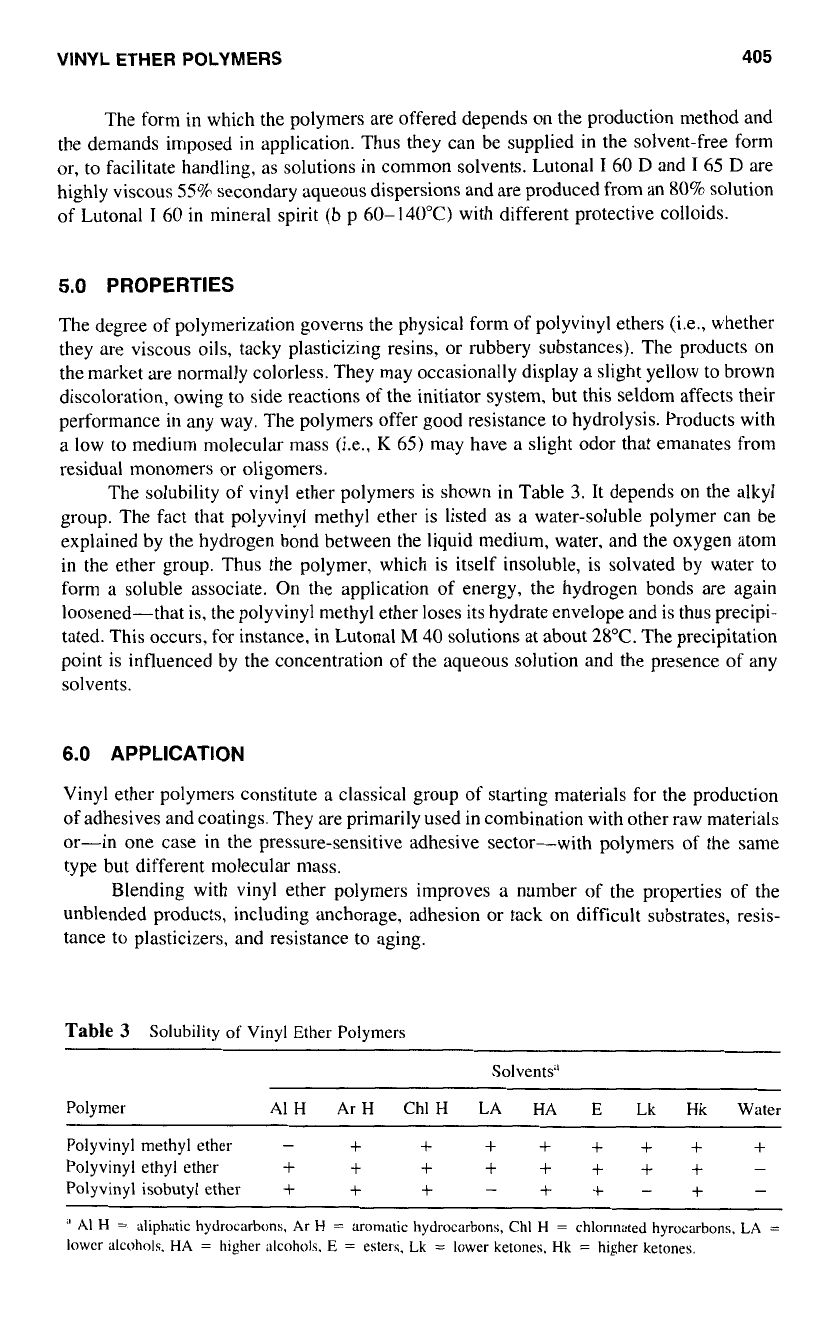
VINYL
ETHER
POLYMERS
405
The form in which the polymers are offered depends on the production method and
the demands imposed in application. Thus they can be supplied in the solvent-free form
or,
to
facilitate handling, as solutions in common solvents. Lutonal
I
60
D
and
I65
D
are
highly viscous
55%
secondary aqueous dispersions and are produced from an
80%
solution
of Lutonal
I
60
in mineral spirit (b p
60-140°C)
with different protective colloids.
5.0
PROPERTIES
The degree
of
polymerization governs the physical form
of
polyvinyl ethers (i.e., whether
they are viscous oils, tacky plasticizing resins, or rubbery substances). The products on
the market are normally colorless. They may occasionally display a slight yellow to brown
discoloration, owing to side reactions of the initiator system, but this seldom affects their
performance in any way. The polymers offer good resistance to hydrolysis. Products with
a low
to
medium molecular mass (i.e.,
K
65)
may have a slight odor that emanates from
residual monomers or oligomers.
The solubility
of
vinyl ether polymers is shown
in
Table
3.
It depends
on
the alkyl
group. The fact that polyvinyl methyl ether is listed as a water-soluble polymer can be
explained by the hydrogen bond between the liquid medium, water, and the oxygen atom
in the ether group. Thus the polymer, which is itself insoluble, is solvated by water to
form a soluble associate. On the application of energy, the hydrogen bonds are again
loosened-that is, the polyvinyl methyl ether loses its hydrate envelope and is thus precipi-
tated. This occurs, for instance, in Lutonal
M
40
solutions at about
28°C.
The precipitation
point is influenced by the concentration of the aqueous solution and the presence of any
solvents.
6.0
APPLICATION
Vinyl ether polymers constitute a classical group of starting materials for the production
of
adhesives and coatings. They are primarily used in combination with other raw materials
or-in one case in the pressure-sensitive adhesive sector-with polymers of the same
type but different molecular mass.
Blending with vinyl ether polymers improves a number of the properties of the
unblended products, including anchorage, adhesion or tack on difficult substrates, resis-
tance to plasticizers, and resistance to aging.
Table 3
Solubility
of
Vinyl Ether Polymers
Solvents"
Polymer A1
H
Ar
H
Chl
H
LA
HA
E
Lk Hk
Water
Polyvinyl methyl ether
-
+
+
+++++
+
Polyvinyl ethyl ether
+ +
+
+++++
-
Polyvinyl isobutyl ether
+
+
+
-
++-+
-
~
I'
AI
H
=
aliphatic hydrocarbons.
Ar
H
=
aromatic hydrocarbons, Chl
H
=
chlorinated
hyrocarbons,
LA
=
lowcr
alcohols.
HA
=
higher
alcohols.
E
=
esters. Lk
=
lower
ketones, Hk
=
higher ketones.
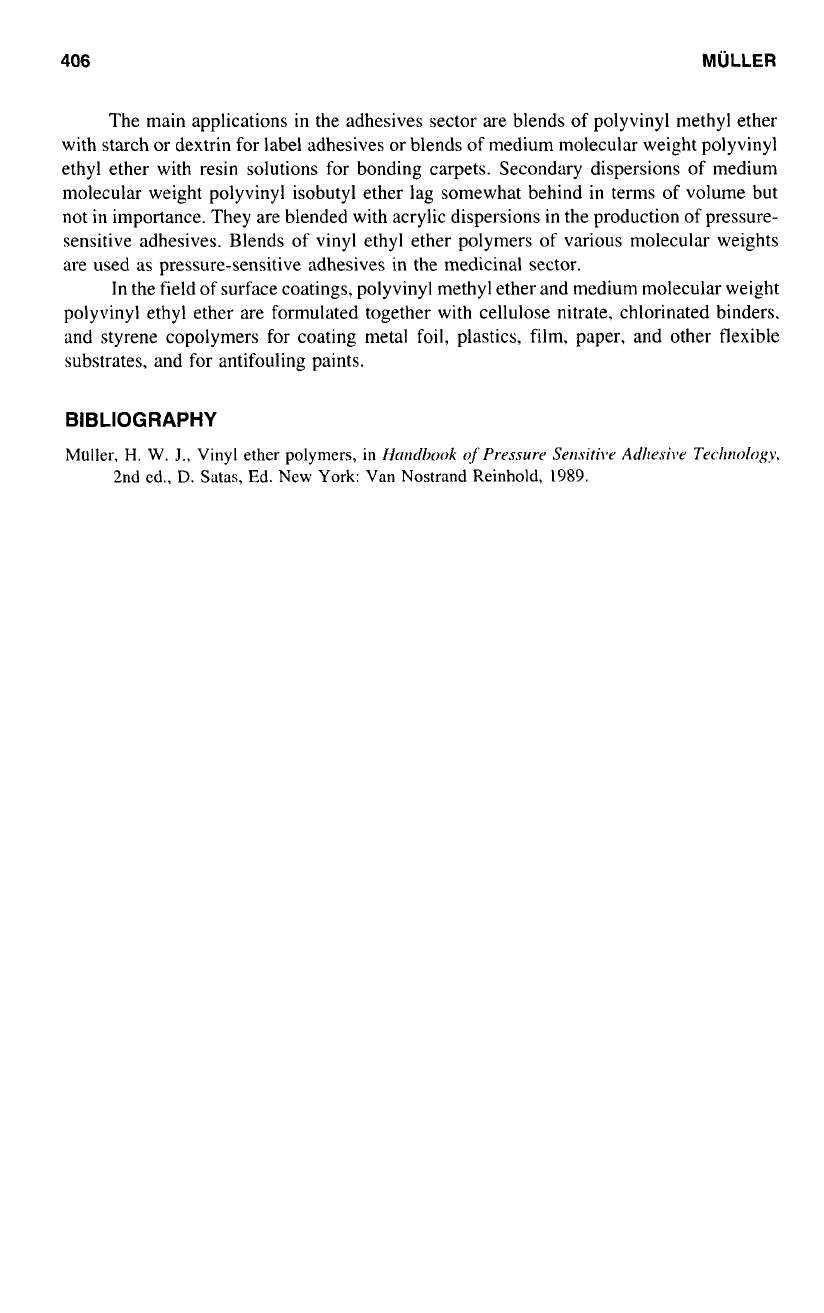
406
MULLER
The main applications in the adhesives sector are blends
of
polyvinyl methyl ether
with starch or dextrin for label adhesives or blends of medium molecular weight polyvinyl
ethyl ether with resin solutions for bonding carpets. Secondary dispersions of medium
molecular weight polyvinyl isobutyl ether lag somewhat behind in terms of volume but
not in importance. They are blended with acrylic dispersions in the production of pressure-
sensitive adhesives. Blends of vinyl ethyl ether polymers of various molecular weights
are used
as
pressure-sensitive adhesives in the medicinal sector.
In the field of surface coatings, polyvinyl methyl ether and medium molecular weight
polyvinyl ethyl ether are formulated together with cellulose nitrate, chlorinated binders.
and styrene copolymers for coating metal foil, plastics, film, paper, and other flexible
substrates, and for antifouling paints.
BIBLIOGRAPHY
Muller.
H.
W.
J.,
Vinyl ether polymers, in
Hmzdlmok
of’
Pressure
Serzsitiw
Adhesive
Trchrzology.
2nd ed.,
D.
Satas, Ed. New
York:
Van Nostrand Reinhold,
1989.
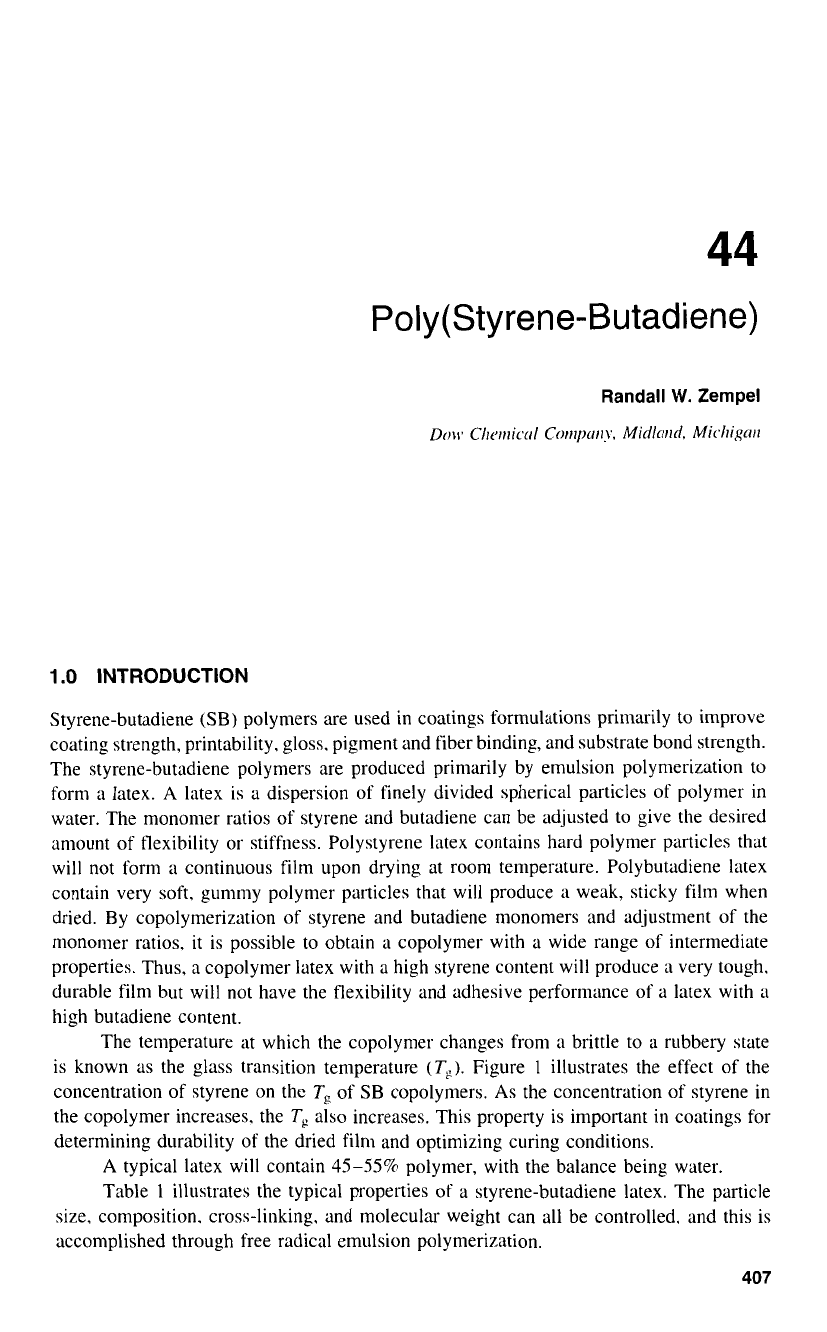
44
Poly(Styrene-Butadiene)
1
.O
INTRODUCTION
Styrene-butadiene (SB) polymers are used in coatings formulations primarily to improve
coating strength, printability. gloss. pigment and fiber binding, and substrate bond strength.
The styrene-butadiene polymers are produced primarily by emulsion polymerization to
form
a
latex.
A
latex is a dispersion of finely divided spherical particles of polymer in
water. The monomer ratios
of
styrene and butadiene can be adjusted to give the desired
amount of flexibility or stiffness. Polystyrene latex contains hard polymer particles that
will not form
a
continuous film upon drying at room temperature. Polybutadiene latex
contain very soft, gummy polymer particles that will produce
a
weak, sticky film when
dried. By copolymerization of styrene and butadiene monomers and adjustment of the
monomer ratios. it is possible to obtain
a
copolymer with a wide range
of
intermediate
properties. Thus, a copolymer latex with a high styrene content will produce
a
very tough.
durable film but will not have the flexibility and adhesive performance of a latex with
;L
high butadiene content.
The temperature at which the copolymer changes from
a
brittle
to
a rubbery state
is known as the glass transition temperature
(Tg).
Figure
1
illustrates the effect of the
concentration of styrene
on
the
Tg
of
SB
copolymers.
As
the concentration of styrene in
the copolymer increases. the
Tg
also increases. This property is important
in
coatings for
determining durability
of
the dried film and optimizing curing conditions.
A
typical latex will contain
4555%
polymer, with the balance being water.
Table
1
illustrates the typical properties
of
a styrene-butadiene latex. The particle
size, composition. cross-linking. and molecular weight can all be controlled. and this is
accomplished through free radical emulsion polymerization.
407
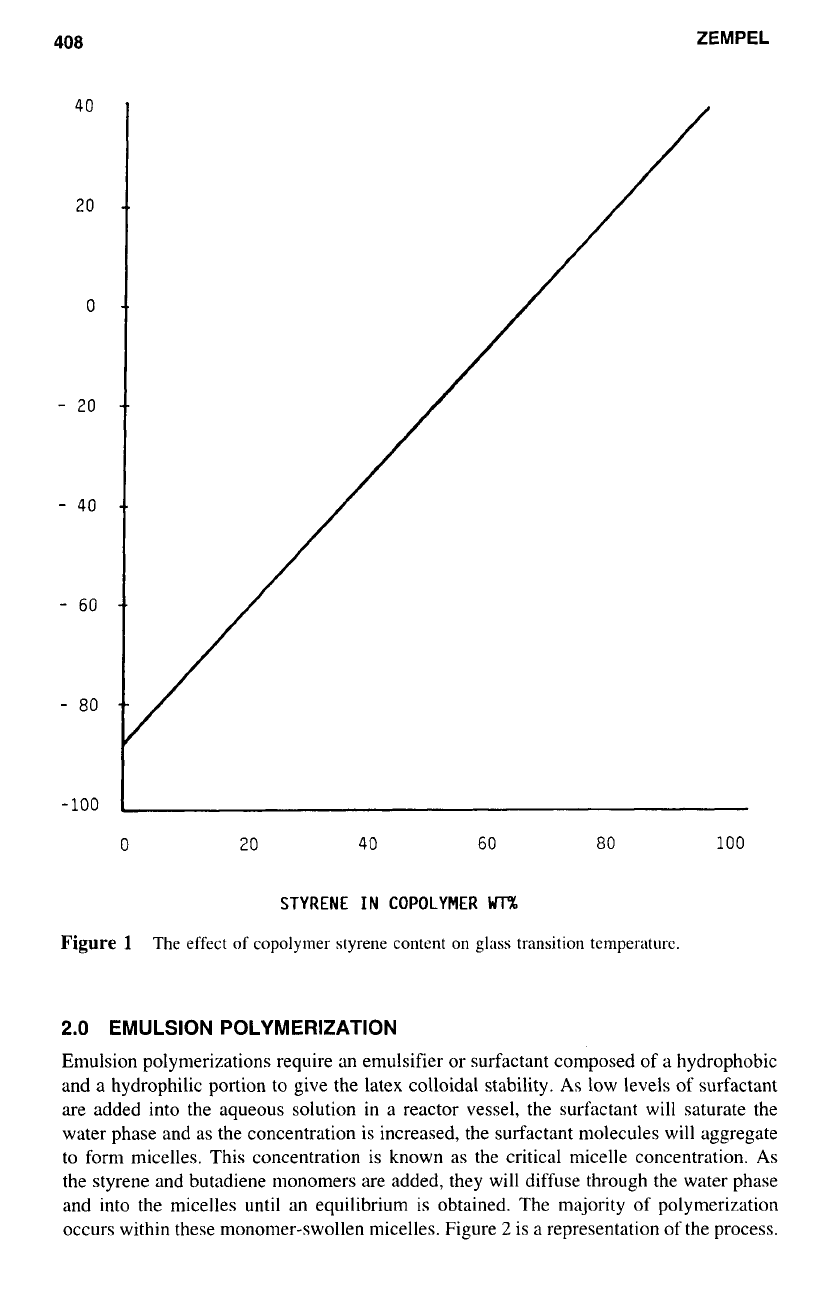
408
40
20
0
-
20
-
40
-
60
-
80
-100
0
20
40
60
80
100
STYRENE IN COPOLYMER
W
Figure
1
The
effect of copolymer styrene contcnt on glass transition tcmperaturc.
2.0
EMULSION POLYMERIZATION
Emulsion polymerizations require an emulsifier or surfactant composed of a hydrophobic
and a hydrophilic portion to give the latex colloidal stability.
As
low levels
of
surfactant
are added into the aqueous solution
in
a reactor vessel, the surfactant will saturate the
water phase and as the concentration is increased, the surfactant molecules will aggregate
to form micelles. This concentration is known as the critical micelle concentration.
As
the styrene and butadiene monomers are added, they will diffuse through the water phase
and into the micelles until an equilibrium is obtained. The majority
of
polymerization
occurs within these monomer-swollen micelles. Figure
2
is
a representation
of
the process.
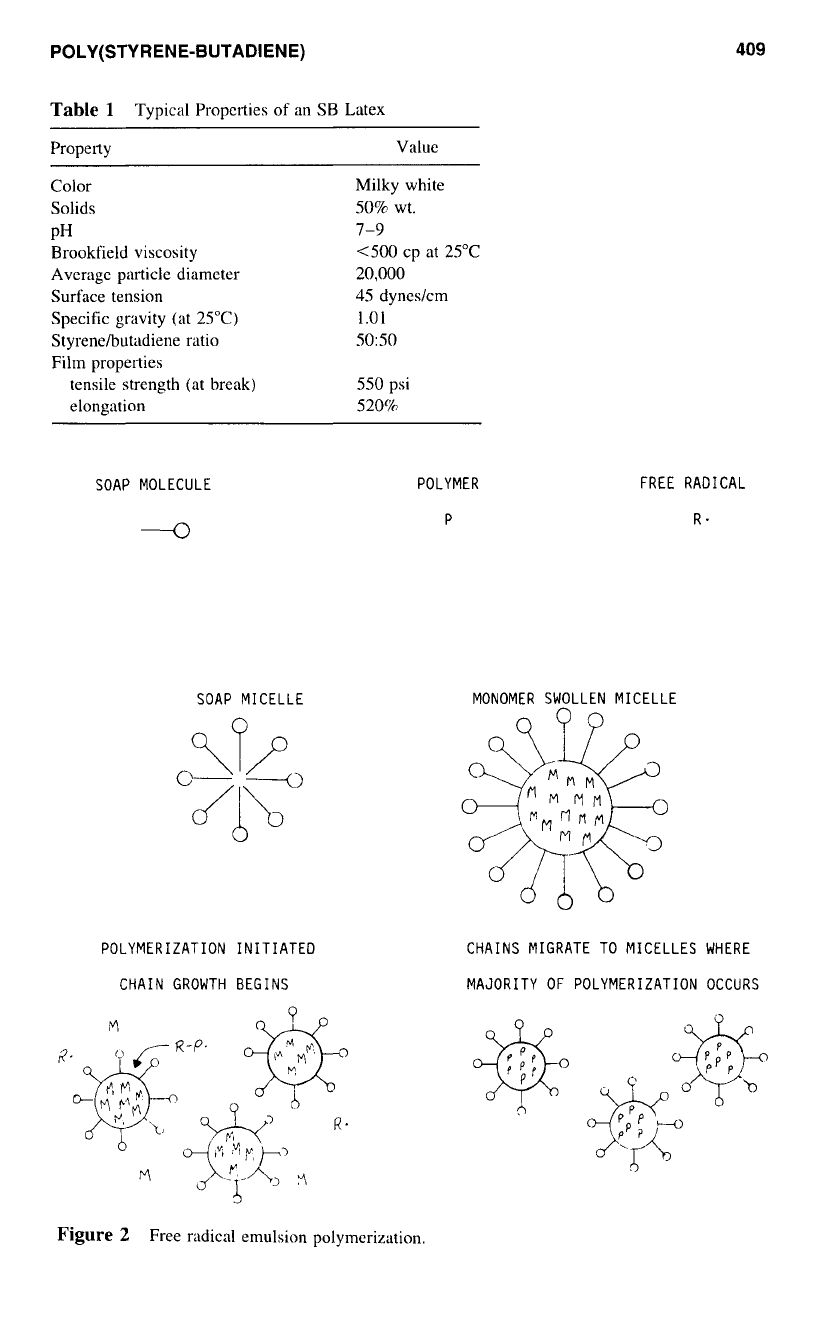
POLY(STYRENE-BUTADIENE)
409
Table
1
Typical Properties
of
an
SB
Latex
Property Value
Color
Solids
PH
Brookfield viscosity
Avcragc particle diamcter
Surface tension
Specific gravity (at 25°C)
Styrenehutadiene ratio
Film properties
tensile strength (at break)
elongation
Milky white
50% wt.
7-9
<500 cp at 25°C
20,000
45
dyneslcm
1.01
50:50
550
psi
520%
SOAP MOLECULE
4
SOAP MICELLE
POLYMERIZATION INITIATED
CHAIN GROWTH BEGINS
c,
Figure
2
Free radical emulsion polymcrization.
POLYMER
P
FREE RADICAL
R-
MONOMER SWOLLEN MICELLE
CHAINS MIGRATE
TO
MICELLES WHERE
MAJORITY
OF
POLYMERIZATION OCCURS
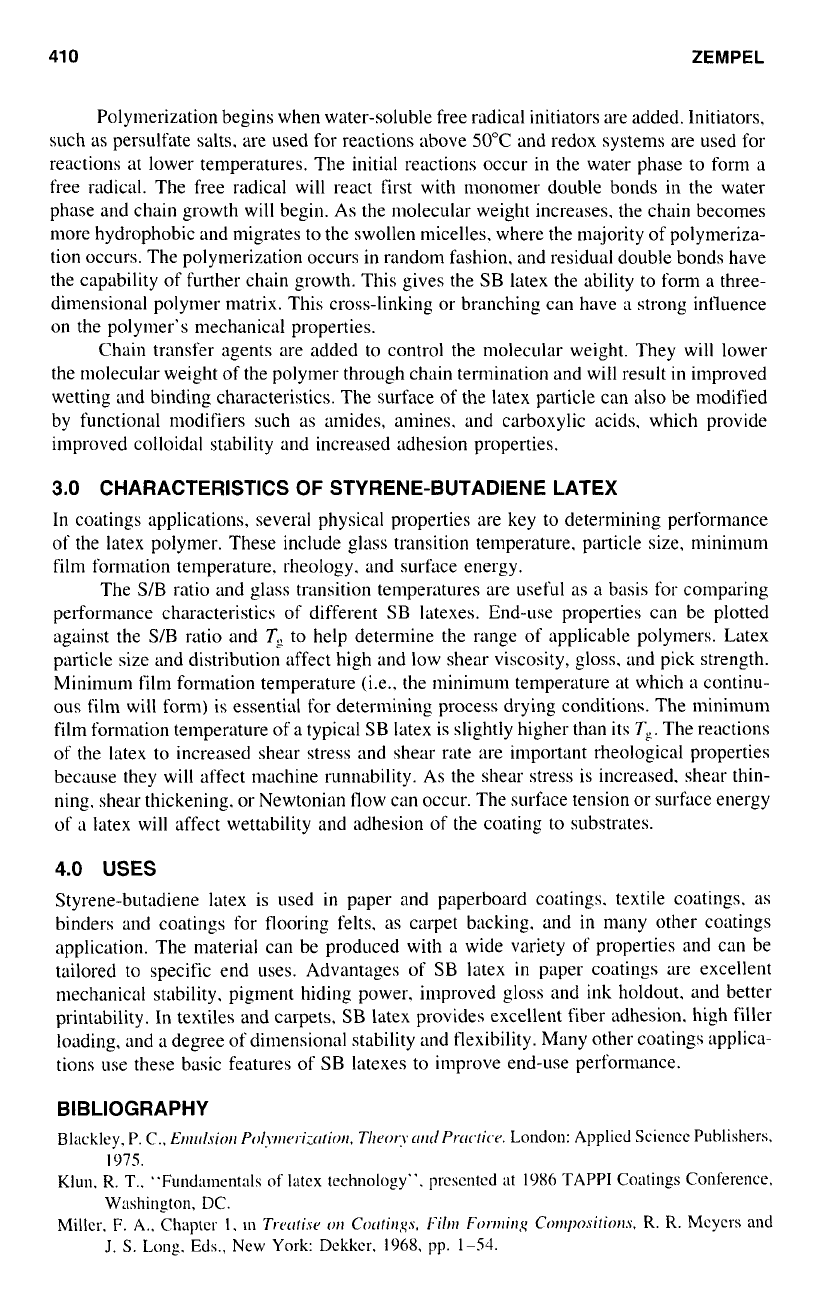
41
0
ZEMPEL
Polymerization begins when water-soluble free radical initiators are added. Initiators.
such
as
persulfate salts. are used for reactions above
50°C
and redox systems are used for
reactions
at
lower temperatures. The initial reactions occur
in
the water phase
to
form a
free radical. The free radical will react first with monomer double bonds in the water
phase and chain growth will begin. As the molecular weight increases. the chain becomes
more hydrophobic and migrates
to
the swollen micelles. where the majority of polymeriza-
tion occurs. The polymerization occurs in random fashion. and residual double bonds have
the capability of further chain growth. This gives the
SB
latex the ability
to
form a three-
dinlensional polymer matrix. This cross-linking or branching can have
a
strong intluence
on the polymer’s nlechanical properties.
Chain transfer agents are added
to
control the molecular weight. They will lower
the molecular weight of the polymer through chain termination and will result in improved
wetting and binding characteristics. The surface
of
the latex particle can also be modified
by functional modifiers such as amides, amines, and carboxylic acids. which provide
improved colloidal stability and increased adhesion properties.
3.0
CHARACTERISTICS
OF
STYRENE-BUTADIENE LATEX
In coatings applications, several physical properties are key
to
determining performance
of
the latex polymer. These include glass transition temperature. particle size, minimum
film formation temperature. rheology. and surface energy.
The
S/B
ratio and glass transition temperatures are useful as
a
basis for comparing
performance characteristics of different
SB
latexes. End-use properties can be plotted
against the S/B ratio and
Ts
to
help determine the range of applicable polymers. Latex
particle size and distribution affect high and low shear viscosity, gloss. nnd pick strength.
Minimum film formation temperature (i.e., the minimum temperature at which
a
continu-
ous film will form) is essential for determining process drying conditions. The minimum
film formation temperature ofa typical
SB
latex is slightly higher than its
T,.
The reactions
of
the latex to increased shear stress and shear rate are important rheological properties
because they will affect machine runnability. As the shear stress is increased. shear thin-
ning. shear thickening. or Newtonian flow can occur. The surface tension or surface energy
of
a
latex will affect wettability and adhesion of the coating
to
substrates.
4.0
USES
Styrene-butadiene latex is used
in
paper and paperboard coatings. textile coatings.
as
binders and coatings for flooring felts, as carpet backing. and
in
many other coatings
application. The material can be produced with a wide variety of properties and can be
tailored
to
specific end uses. Advantages of
SB
latex
in
paper coatings are excellent
mechanical stability. pigment hiding power. improved gloss and ink holdout. and better
printability. In textiles and carpets,
SB
latex provides excellent fiber adhesion. high filler
loading, and
a
degree of dimensional stability and tlexibility. Many other coatings applica-
tions use these basic features of
SB
latexes
to
improve end-use performance.
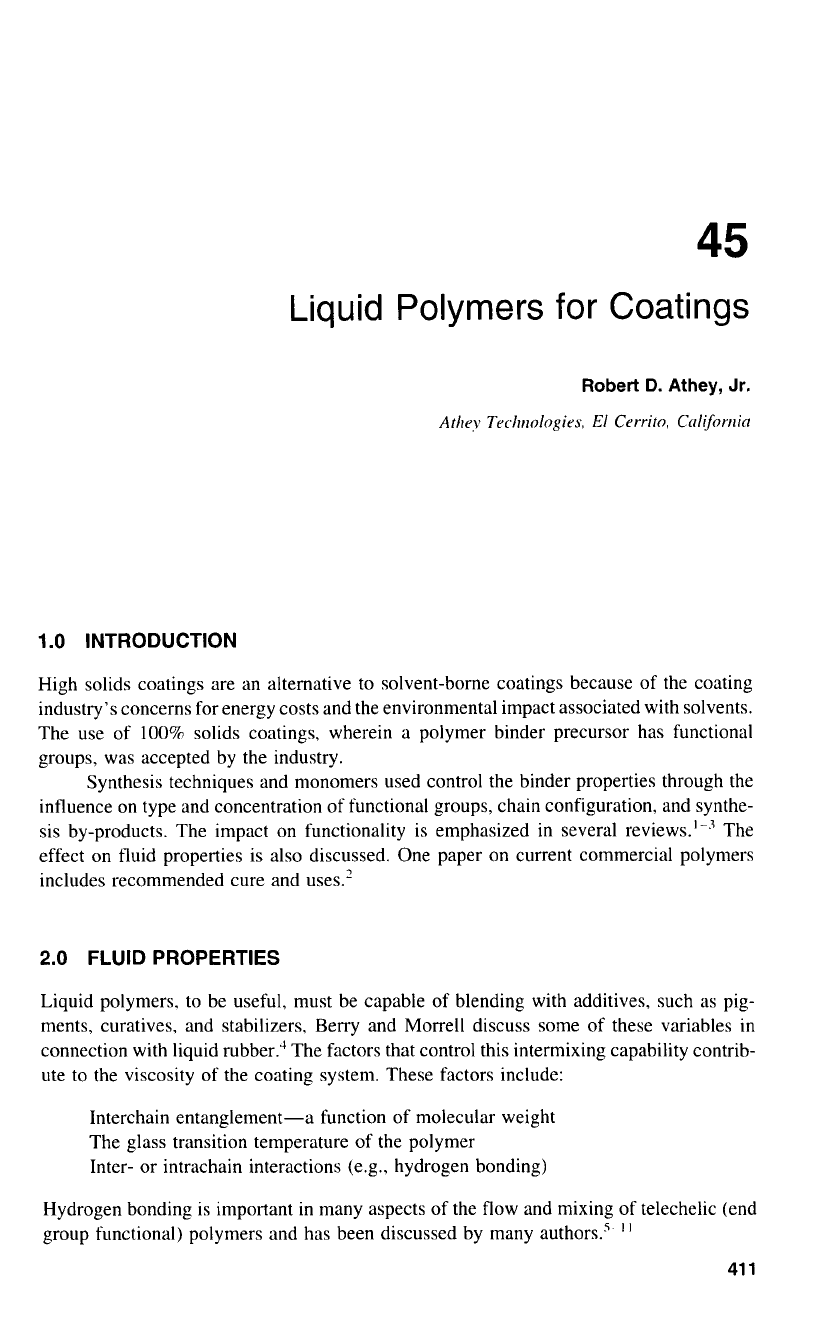
45
Liquid
Polymers
for
Coatings
Robert
D.
Athey,
Jr.
Athey Techrlologies,
El
Cerriro, Crrlifonria
1
.O
INTRODUCTION
High solids coatings are an alternative
to
solvent-borne coatings because of the coating
industry's concerns for energy costs and the environmental impact associated with solvents.
The use of
100%
solids coatings, wherein a polymer binder precursor has functional
groups, was accepted by the industry.
Synthesis techniques and monomers used control the binder properties through the
influence on type and concentration of functional groups, chain configuration, and synthe-
sis by-products. The impact
on
functionality is emphasized in several reviews." The
effect on fluid properties
is
also discussed. One paper
on
current commercial polymers
includes recommended cure and uses.?
2.0
FLUID PROPERTIES
Liquid polymers, to be useful, must be capable of blending with additives, such
as
pig-
ments, curatives, and stabilizers, Berry and Morrell discuss some
of
these variables in
connection with liquid rubber." The factors that control this intermixing capability contrib-
ute to the viscosity of the coating system. These factors include:
Interchain entanglement-a function of molecular weight
The glass transition temperature
of
the polymer
Inter- or intrachain interactions (e.g., hydrogen bonding)
Hydrogen bonding is important
in
many aspects
of
the flow and mixing of telechelic (end
group functional) polymers and has been discussed by many authors.'
'I
41
1
